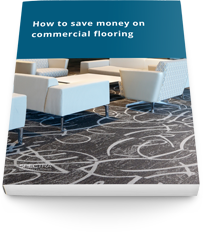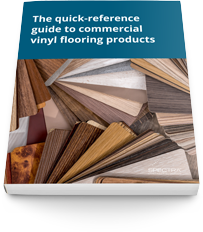Linoleum vs Vinyl: A Buyer’s Guide
Often confused with one another, linoleum and vinyl flooring are two different flooring options that belong to the resilient side of the family. While it’s true that the pair shares certain similarities, it’s also important to understand key differences. Here, we will examine the advantages and disadvantages of linoleum vs vinyl flooring to help you distinguish between the two and determine which product best meets your needs.

Linoleum Advantages and Disadvantages
As a green, environmentally friendly flooring solution, linoleum is made from all natural materials and is completely recyclable and reusable. It is also non-emitting and biodegradable, meaning that it will not cause any indoor air pollution and will not prolong landfill space like vinyl or other synthetic materials. From a design perspective, linoleum is extremely versatile, comfortable and soft underfoot, and durable enough to last upwards of 40 years if properly cared for and maintained.
While linoleum has many advantages, it also comes with some disadvantages. First, while it is comfortable underfoot, linoleum is a softer flooring solution which makes it susceptible to being torn or scratched by things such as rolling medical equipment or heavy furniture. Left unsealed, linoleum requires periodic buffing and polishing as its surface can show signs of wear more quickly than that of a sealed approach. Linoleum is also vulnerable to moisture damage as it tends to expand and contract when exposed to moisture; thus making it a poor applicant for bathrooms or areas below ground level.
Vinyl Advantages and Disadvantages
While there are many vinyl flooring options, they typically fall into three broad categories: vinyl composition tile (VCT), luxury vinyl tile (LVT) and sheet flooring. One of the biggest advantages that these products have over many of its counterparts is their ability to resist water and moisture. An expertly installed vinyl floor is mostly impervious to water penetration, making it the perfect solution for areas susceptible to moisture such as kitchens and bathrooms. Considered highly durable, vinyl is capable of lasting upwards of 10-20 years if properly cared for and maintained depending on the quality and type of materials chosen. Resistant to scuffing and staining, mold and mildew, and slips and falls, vinyl has all the capabilities of meeting many, if not all, commercial facility requirements.
The drawbacks of vinyl flooring include chemical staining and more of a negative impact on the environment. While vinyl is generally resistant to stains, it is, however, susceptible to discoloration from contact with rubber. Rubber backing mats have been known to cause a chemical reaction when paired with vinyl’s surface. Moreover, unlike linoleum, vinyl flooring is non-biodegradable—often taking up space in landfills as it does not naturally break down into the environment.

How to save money on commercial flooring: value engineering, better materials and smarter solutions
Read this brief, no-nonsense guide to arm yourself with 350,000 projects worth of unbiased, money-saving insights.
Take the guesswork out of vinyl product selection
The exponential growth —and change— in the vinyl flooring category means that designers, architects and facility managers must work tirelessly to stay abreast of trends, advancements and product releases.
This guide cuts through the noise, offering you quick takeaways about the pros, cons, price and performance of different commercial vinyl flooring products. Use it to specify the product best-suited for your budget, performance and design needs on this project — and bookmark it to help on the next one.
You’ll receive:
- A quick-reference chart explaining the cost and performance differences between LVT, sheet vinyl and VCT products.
- An in-depth look at each product type: What it is, when to specify it and how to maintain it.
- Information about what the flooring industry’s installation skills gap means to GCs, designers and owners — and how to overcome it.
- A list of four must-read resources to learn more about commercial vinyl flooring products.
Fill out the form below to download the product guide.

Reference guide to commercial vinyl flooring products
Take the guesswork out of vinyl product selection. This guide cuts through the noise, offering you quick takeaways about the pros, cons, price and performance of LVT, VCT and vinyl sheet flooring.
